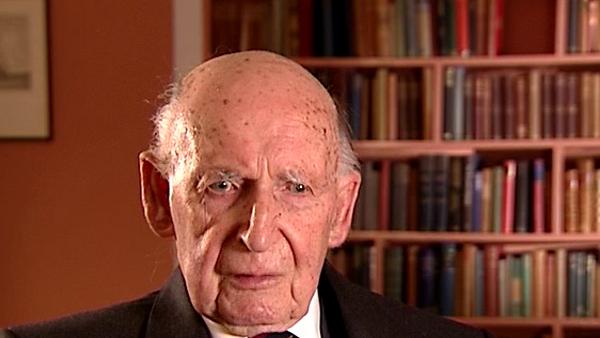NEXT STORY

Good fortune paves the way for the MK I Radio Telescope
RELATED STORIES

NEXT STORY

Good fortune paves the way for the MK I Radio Telescope
RELATED STORIES



Now, the sequence of events then are really very confused, and they cover the years from about 1950 to about 1952. Husband was given a contract to make a design study of this telescope. My specification was perfectly straightforward, that it should be a paraboloid with a mesh of four, with a bowl... a reflecting bowl with a mesh of four inches, and that it should be rotatable, so that it could be moved to any part of the sky. So the beam could be directed at any part of the sky. Husband got his father to – who was then the Professor of Engineering in Sheffield – to make a sketch of what was possible. And in fact that... the original of that sketch is hanging in the room from which I'm speaking at the moment. It shows quite a marked resemblance to... with many... much imagination of what eventually evolved.
Now, the various estimates as to how much was this was cost... this would cost, began to increase. I think first of all it was somewhere in the order of £100,000. Then various modifications, which I put in, and which Husband put in, increased the cost, until in 1952 I finally applied to the DSIR for the construction of this radio telescope at a cost of £300 and... I think it was £330,000.
Well, now, now this was in 1951. In 1951, I submitted this application with what became known as the Blue Book. And compared with the glossy and expensive publications, which would accompany such an application today, this was a book, which we had stencilled on... ourselves, on paper, and contained a number of chapters by myself and by Clegg. I wrote on what it would do, Clegg wrote, and I then had JG Davis working with me, and he wrote on the possibility of control mechanism. Now, this Blue Book... a few copies still exist, and it must be rather precious, I think, because we circulated about two dozen copies, which we had hand stencilled at Jodrell Bank, and got somebody to bind. Now, I do not know the exact proceedings, which went on behind the scenes, after DSIR received this application. The plain fact is that I was asking for a very, very large sum of money. And I do not want to constantly repeat this figure, but any sums I might mention now, compared with today's prices – I'm talking about 2007 – you have to multiply by a factor of something between 25 and 30, just to allow for the official index for the increased cost of living and so on. So in asking for £330,000, in 1951, it was the equivalent to asking for several million pounds today.
Bernard Lovell (1913-2012), British radio astronomer and founder of the Jodrell Bank Observatory, received an OBE in 1946 for his work on radar, and was knighted in 1961 for his contribution to the development of radio astronomy. He obtained a PhD in 1936 at the University of Bristol. His steerable radio telescope, which tracked Sputnik across the sky, is now named the Lovell telescope.
Title: Getting the funding for the MK I Radio Telescope
Listeners: Megan Argo Alastair Gunn
Megan Argo is an astronomer at the University of Manchester's Jodrell Bank Observatory researching supernovae and star formation in nearby starburst galaxies. As well as research, she is involved with events in the Observatory's Visitor Centre explaining both astronomy and the history of the Observatory to the public.
Alastair Gunn is an astrophysicist at Jodrell Bank Observatory, University of Manchester. He is responsible for the coordination and execution of international radio astronomical observations at the institute and his professional research concerns the extended atmospheres of highly active binary stars. Alastair has a deep interest and knowledge of the history of radio astronomy in general and of Jodrell Bank in particular. He has written extensively about Jodrell Bank's history.
Tags: Sheffield, Jodrell Bank, Department of Scientific and Industrial Research, Charles Husband, J A Clegg
Duration: 4 minutes, 12 seconds
Date story recorded: January 2007
Date story went live: 05 September 2008